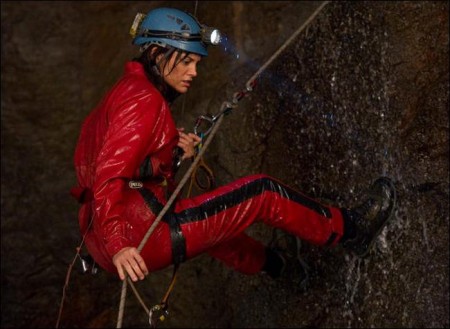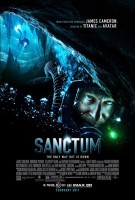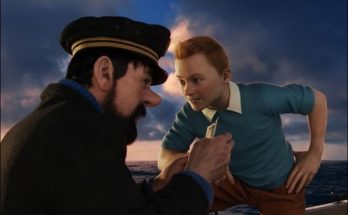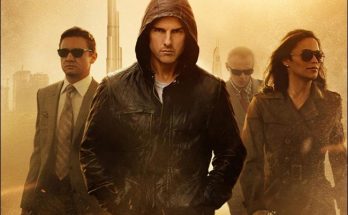Taglines: The only way out is down.
The 3D action-thriller Sanctum, from executive producer James Cameron, follows a team of underwater cave divers on a treacherous expedition to the largest, most beautiful and least accessible cave system on Earth. When a tropical storm forces them deep into the caverns, they must fight raging water, deadly terrain and creeping panic as they search for an unknown escape route to the sea.
Master diver Frank McGuire (Richard Roxburgh) has explored the South Pacific’s Esa-ala Caves for months. But when his exit is cut off in a flash flood, Frank’s team–including 17-year-old son Josh (Rhys Wakefield) and financier Carl Hurley (Ioan Gruffudd)–are forced to radically alter plans. With dwindling supplies, the crew must navigate an underwater labyrinth to make it out. Soon, they are confronted with the unavoidable question: Can they survive, or will they be trapped forever?
Shot on location off the Gold Coast in Queensland, Australia, Sanctum employs 3D photography techniques Cameron developed to lens Avatar. Designed to operate in extreme environments, the technology used to shoot the action-thriller will bring audiences on a breathless journey across plunging cliffs and into the furthest reaches of our subterranean world.
About the Production
In 1988, producer and renowned caver Andrew Wight led an expedition to explore and dive into a remote cave system hidden beneath the Nullarbor Plain in Australia. During the course of his trip, a freak storm caused the cave entrance to collapse, leaving 15 people trapped deep underground. A rescue mission was mounted and, incredibly, everyone survived the harrowing ordeal. The experience left an indelible mark on Wight and led him to develop, with longtime colleague James Cameron, a film inspired by these life-changing events. Along with writer John Garvin.
Wight crafted a classic coming-of-age story about a young man who is at odds with his father before the ultimate test of survival brings them together. Set in an alien world that is as beautiful as it is terrifying, their screenplay examined the strength and fragility of the bonds that develop when we are faced with the onslaught of nature and our very possible death. At the center of the story is a team of underwater cave divers who are in the middle of an expedition in the most beautiful, most unexplored cave system in the world. We meet tough-as-nails master explorer Frank McGuire, his 17-year-old son Josh, who is participating under absolute protest, and billionaire Carl Hurley, who is underwriting the expedition.
When a tropical storm arrives suddenly, the team’s only exit is cut off in a flash flood, and they are forced to move forward deeper into the uncharted cave to escape the raging water. With lights and supplies vanishing fast, they must navigate the treacherous terrain and brutally cold water in search of a theoretical escape route to the sea. But the labyrinthine cave is unforgiving of mistakes, and soon they are all confronted with this looming question: Will any of them make it out alive?
Executive producer James Cameron shares how the partnership began: “Five years ago, Andrew Wight, my longtime collaborator, brought me the idea for Sanctum, and I loved it. Andrew and I had previously been on some great adventures together. We dove deep into the ocean to uncharted depths to explore and discover never-before-seen parts of the ocean floor and marine life for Aliens of the Deep. We dove the Titanic [for Ghosts of the Abyss] and the Bismarck.”
Along the way, the men developed a new photographic system that could operate in these extreme environments and deliver a cinematic experience that Cameron describes as “beyond any other.” He explains: “It’s a system I was thrilled to use on Avatar and which Andrew utilized on Sanctum: the Cameron/Pace Fusion 3D Camera System—a stereoscopic HD camera system that delivers such incredible results that we can deliver flawless IMAX projection in 3D. But as mind-blowing as all this new technology is, filmmaking is not about the equipment. It’s about ideas, images and imagination. It’s about storytelling, and I believe in this story.”
Though Wight and Garvin had their genesis for Sanctum from Wight’s life experience, the men didn’t want to re-create the almost ill-fated trip as a documentary. The writer/producer offers: “Rather than tell that exact story, it was far more exciting to use the essence of the experience. We wanted to drill down and look at what happens to people when they are in a difficult environment, under extreme pressure. How do they survive? Our story is about a group of people who are on an expedition in the wilds of Papua New Guinea and become trapped. It becomes a story of survival and self-discovery in an alien environment. We explore how they will react under such extreme pressure.”
Partnering with Wight on script duties was an easy decision for Garvin. He explains how he joined the production: “Andrew and Jim realized they wanted to make a cave-diving movie, and they were looking around for writers. I had quite an extensive diving background, so I was able to bring realism to the screenplay that they were looking for. Having some diving experience was very useful for writing the screenplay. For most people, the thought of being in an underwater cave system is the most frightening thing they can imagine, but the reality of it is that underwater caves are the most beautiful, serene places you can imagine. They are absolutely silent, very dark, and it’s just the sound of your own breathing down there. Believe it or not, most cave divers dive to relax.”
He agreed with Cameron and Wight’s core idea not to make the film simply a diving adventure, but one that focuses on a family and a group of friends who must cope when everything “is stripped away.” Garvin adds: “We were very careful to make sure that the screenplay is fundamentally a father and son story. It’s a rite of passage about a young man learning lessons from his father, as well as the environment of the cave, before he becomes a man.”
After a thorough search, Cameron and Wight selected Alister Grierson to helm Sanctum. The two men responded to the feature debut from the young Australian director, who had made quite a name for himself soon after film school. In 2006, he directed Kokoda, one of that year’s top-grossing Australian films. The drama told the true story of a platoon of soldiers lost in the New Guinea jungles during a pivotal World War II battle in 1942. It was met with praise from audiences and critics alike. Cameron offers that they were looking for a young filmmaker, but not a director who was a novice. “We wanted someone who had already made their first mistakes and someone who could show us something,” he says. “We wanted someone with a vision who knew how to accomplish it. And Alister did that with Kokoda. It was a very strong f irst film, and he presented himself as a director with a real opinion.”
Once Cameron and Wight believed that Grierson was the ideal candidate for the job, they spent some time with the director to gauge his intentions for the project. But it was a trial by submersion that sealed the deal for the filmmakers. Cameron laughs: “Andrew took Alister cave diving and scared the crap out of him, but he kept it together and came out with a real respect and understanding for caving. At that point, he was 100 percent ready to make the film. The most challenging part for him was to learn how to work with 3D. It’s not like he came to us and said, ‘I want to make a 3D film.’”
But that was in their plans from the beginning. Cameron adds: “We said, ‘We want you to direct this film, and it’s going to be in 3D.’ So he and his director of photography, Jules O’Loughlin, had to convert from shooting film to HD. They had to learn to light for the digital cameras, how to use the stereo space and how to use this whole new camera system. To do all that for only their second feature was all pretty daunting, but they stepped up and mastered it. They didn’t let us down.”
Grierson admits that he was not only drawn to the project because of the chance to work with Cameron and Wight, but he was also attracted to the story because of its underlying themes. “I’m interested in stories of human beings under pressure and how they react to those circumstances,” he says. “Kokoda had a lot of similar elements. Sanctum has a very strong father-son relationship in its story, which appealed to me. The 3D element is the icing on the cake, although I do think that when audiences see this film in 3D, it will open up a whole new world that they haven’t previously experienced.”
Sanctum 3D
Directed by: Alister Grierson
Starring: Richard Roxburgh, Ioan Gruffudd, Rhys Wakefield, Alice Parkinson, Dan Wyllie, Allison Cratchley
Screenplay by: John Garvin, Andrew Wight
Production Design by: Nicholas McCallum
Cinematography by: Jules O’Loughlin
Film Editing by: Mark Warner
Art Direction by: Jenny O’Connell
Music by: David Hirschfelder
MPAA Rating: R for language, some violence and disturbing images.
Studio: Rogue Pictures
Release Date: February 4, 2011
Hits: 75





